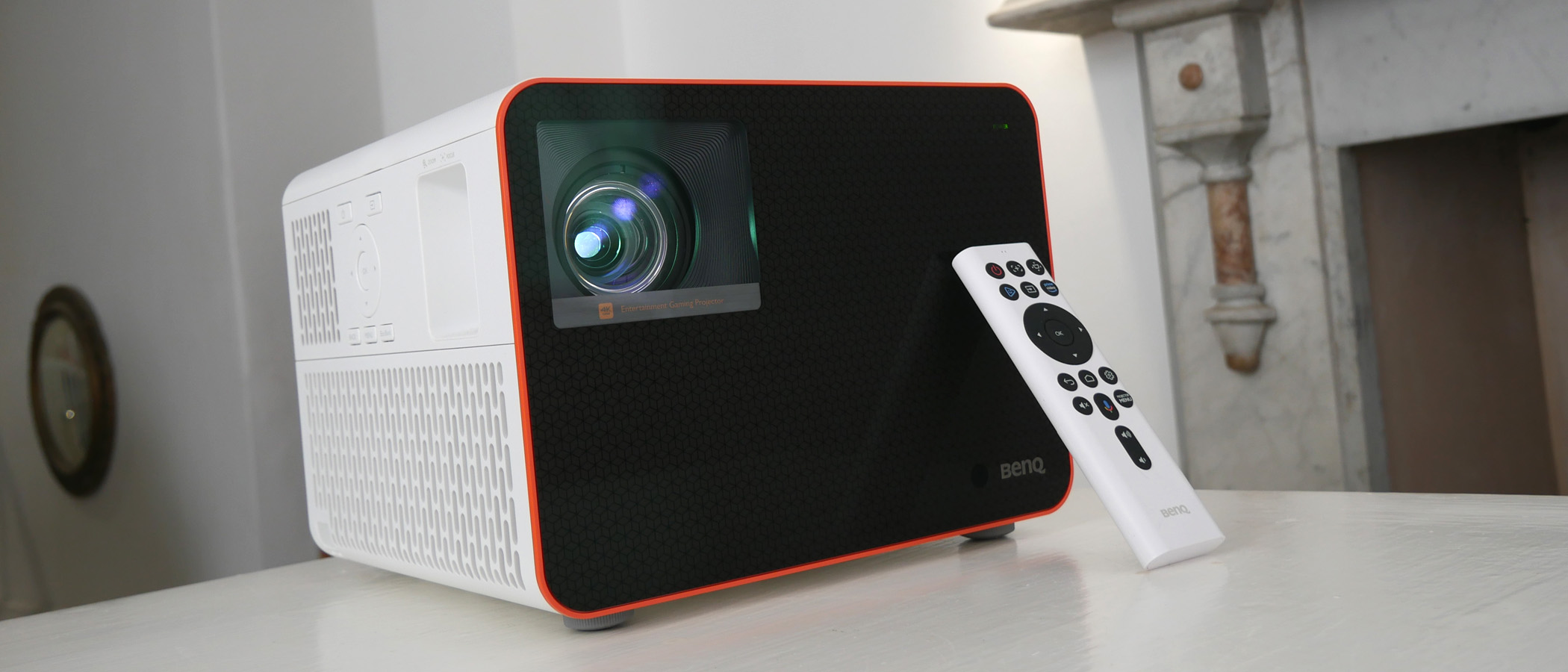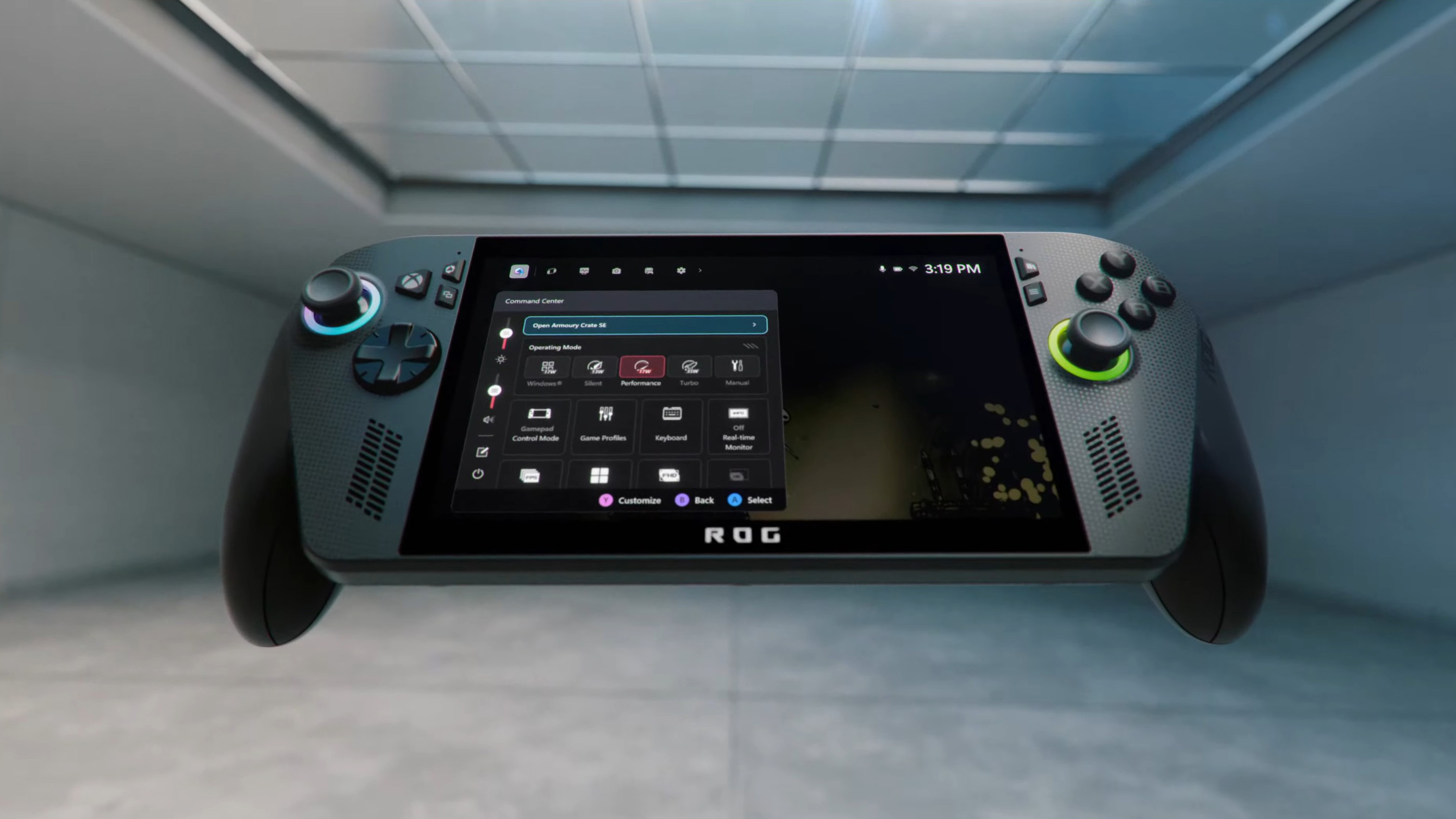
BenQ's unusual box-shaped beamer packs a 240Hz, 3000 lumens punch.
Forget HDTVs or oversized, uber-wide monitors. If you want a truly epic, cinematic gaming experience, there can be only one option. A projector. Cue the hot new BenQ X3000i, one of a burgeoning breed of beamers that are expressly designed for gaming.
You can, of course, game with pretty much any projector. Indeed, pixel-shifting 4K projectors can now be had for relatively little money. What you don’t generally get from cheaper models are any features for improving the gaming experience. Typically, you’ll be looking at refresh rates limited to 60Hz and relatively little attention paid to latency.
Arguably even more important, cheaper projectors tend to be dimmer projectors. For home cinema applications, that’s OK. The idea is that you’re largely, if not exclusively, using the thing for serious content consumption of an evening in a room where the ambient light levels are under some sort of control.
But gaming? You’re much more likely to want to do that at almost any hour and it might not be terribly convenient to block out ambient light every time you want to have a quick session. Which is where the BenQ X3000i comes in. As its name implies, this is a beamer capable of fully 3,000 lumens. That’s two to three times the brightness of a typical budget projector. Inevitably, that brightness comes at a cost, here you’re looking at $1,999 (£1,916), while basic 4K DLP projectors can be had for half the money.
Still, the extra cash also nets you a 240Hz refresh rate and a claimed input latency of just 4ms along with that full 4K resolution. Yes, the X3000i is based on a 1080p DLP chip, not a true 4K chip. However, using clever DLP pixel shifting technology you do get all 3,840 by 2,160 pixels. That’s not true of 4K LCD projectors with pixel shifting tech, which don’t deliver a true 4K pixel grid.
(Image credit: Future)
Projector type: DLP
Lamp type: 4-LED
Brightness: 3000 lumens
Native resolution: 3,840 x 2,160 (with pixel shift)
Refresh: 60Hz @ 4K, 240Hz @ 1080p
Contrast: 500,000:1 (dynamic)
Colours: 30-bit, 100% DCI-P3
Lamp life: 20,000 hours (30,000 Eco)
Throw ratio: 1.15–1.15
Zoom ratio: 1.3x
Lens shift: No
Audio-out: Yes (3.5mm stereo)
Inputs: 3x HDMI 2.0
Price: $1,999 | £1,916
There is, however, at least one catch. The BenQ X3000i can’t combine 4K with 240Hz. In fact, it can’t even do 4K and 120Hz. The high refresh functionality is limited to 1080p and below. While you wouldn’t expect the X3000i to do 4K and 240Hz—not least because you’d need a DisplayPort 2.0 interface to support that—4K at 120Hz would have been nice. For the record, the X3000i is limited to HDMI 2.0 rather than HDMI 2.1, the latter being required for 4K@120Hz. It’s also worth noting that variable refresh is not supported.
Anyway, the X3000i’s gaming prowess aside, what does it have going for it? BenQ claims fully 100% coverage of the DCI-P3 digital cinema gamut, which is nice, along with full HDR support. In part that’s enabled by a four-LED light source, which is rated at 20,000 hours. No more worrying about lamp life, the traditional projector bugbear of yore.
The X3000i also sports an eight-segment light wheel, which bodes well for avoiding that other DLP-specific projector issue, namely the rainbow effect. As for optics, the X3000i has a throw ratio of 1.15 to 1.5 to one, 1.3x zoom, and manual focus. So, while it’s not strictly a short-throw projector, you don’t need a huge room to get a large image. By way of example, positioned 10 feet from your screen, the X3000i will produce a 105-inch image.
Less edifying is the lack of lens shift. That’s really limiting in terms of where you install this projector. For a given screen positioning you only have two fixed locations where the projector will achieve correct geometry. The optics required for lens shift are more complex and expensive, which is why it’s rarely seen on cheaper projectors. But with the X3000i’s relatively beefy pricing, its absence is felt.
(Image credit: Future)
Whatever, it’s all wrapped up in an unusual cubed-shaped chassis. That’s at least in part to allow for the TreVolo audio system combining dual 5W speakers. The final feature of note is the bundled Android streaming dongle. It’s primarily nice to have because its functionality is integrated into the X3000i’s remote and thus means you don’t need to have two remote controls, as you will with a third-party HDMI dongle. BenQ also provides a neat slot and dedicated HDMI port with USB power under the top cover to house the dongle, leaving the two rear HDMI ports free for a PC and console gaming combo.
But what of the actual viewing experience? The X3000i is certainly punchy. The impact of the 3000 lumens is very noticeable compared to, say, a 1,500 lumen cinema-orientated projector. We’re still not convinced the X3000i really works in a brightly lit room full of ambient daylight. Truly, no projector no matter how bright is great in such conditions. What the X3000i does allow, however, is a few more options to enjoy gaming without having to be super careful about a bit of background light. Just don’t go thinking this is a great option for all-purpose day and night gaming, it’s a bit more limited than that.
The colour saturation does become a little OTT, but it’s not a huge distraction.
In general projector image quality terms, the BenQ X3000i is good but not great. At 4K resolution, the pixel definition is pretty good—close to that of a true native 4K projector—and the colours in cinema mode are fairly natural and convincing. Dip into one of the brighter modes, including gaming mode, and the colour saturation does become a little OTT, but it’s not a huge distraction.
Less convincing are the contrast and black levels. Even in cinema mode, black tones are a little washed out and grey, a problem that increases with the brighter presets. Put simply, we wouldn’t recommend this projector if your main remit is watching movies and TV with a little gaming on the side.
(Image credit: Future)
But as a pure gaming beamer? Well, that’s different. For sure, in darker gaming scenes, we’d prefer more contrast. But most of the time, the zing and sizzle of those 3000 lumens is a lot of fun. What’s more, running at 240Hz and 1080p, this is undoubtedly a very responsive projector. You really can enjoy online shooters with this thing.
That said, we’re not sure many people are going to want to sit at a desk with keyboard and mouse playing games on a projector. So, the X3000i arguably lends itself more to games that work well with handheld controllers. At which point, running at 4K and 60Hz probably makes sense in terms of the overall visual spectacle. Whichever resolution or refresh rate you run at, the good news is that there’s little if any visible rainbow effect thanks to that eight-segment light wheel.
All told, there’s loads to like here. Put it this way, you haven’t lived until you’ve seen something like Cyberpunk 2077 running at full reheat on a punchy 4K projector. It’s something else. Likewise, playing Rocket League on a huge screen with a good sound system blasting away feels like you’re actually in the stadium. It’s a lot of fun.
(Image credit: Future)
(Image credit: Future)
(Image credit: Future)
(Image credit: Future)
(Image credit: Future)
(Image credit: Future)
(Image credit: Future)
(Image credit: Future)
(Image credit: Future)
(Image credit: Future)
(Image credit: Future)
Speaking of audio, those TreVolo stereo speakers may be better than the tiny mono speaker most projectors house. But you still wouldn’t want to actually game with it or watch movies. The sound quality is very muddy and flat. You’ll need some proper speakers, to be sure. For the record, the bundled Android TV dongle works well and will stream at full 4K, which is critical in our view, albeit the range of apps on offer is a bit limited and notably doesn’t include Netflix, and the projector has stereo audio-out, which is essential when using streaming dongles.
All of which makes the BenQ X3000i an interesting but not totally compelling proposition. We like the punchy brightness. But at this price point, we’d prefer a projector with lower brightness but better optics including lens shift and accept that ambient light levels need to be kept under control.



